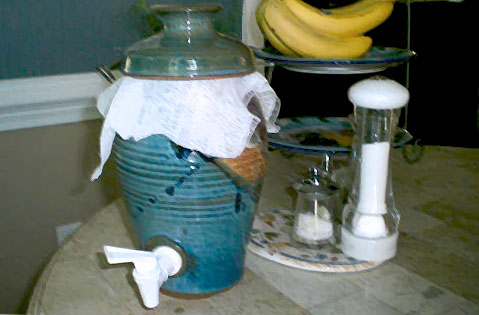Recipe: How to Make Home-Brewed Vinegar
Story and photo by Matt “I Love to Ferment Things” Young.
Cary, NC – I got a hand-thrown pottery vinegar fermenter for Father’s Day. I even asked for it. One of my daughter’s responses when I asked for it was, “You have odd hobbies, dude.”
For years I have made my own vinegar. For a bunch of reasons. It’s simple, it’s cheap, it’s much better than store-bought, we eat salad (Italian dressing) with every meal and as a result, we use vinegar pretty much every day.
Mothers
I was in grade school, when my now dear departed mom pointed out a “mother” growing in the vinegar jar. My brothers’ response to this gelatinous blob growing in the bottle, I am sure was something like, “gross!” Mine was, “That’s cool.” Anyway, she proceeded to show me how to use it to make vinegar at home. My folks were doing the “sustainable thing” in many ways before it was “cool”. I never forgot that.
You can use the leftover wine from a party, if you want. No matter where you source this “food” for the acetobacter to do its thing to make vinegar, start with something you like to drink. It’s the same as the rule for cooking with wine, it should be “drinkable”. I’ve used home-made raspberry, peach and strawberry wine as a base, as well as the usual commercial grape stuff.
Sure-fire Simple Way to Make Vinegar at Home
- Get a hold of a mother of vinegar. You can find them, sometimes called “vinegar starter”, on the internet – even places like Amazon.com.
Note: technically you can simply get a jar of wine and leave it in the garage covered with cheesecloth (keeping the bugs out) and a rubber band for a few months and the natural goonies in the air will convert it to vinegar without a mother. - Get a glass or ceramic 1 gallon vessel.
- Pour in 2 cups of wine – I recently used a home-made Chianti (an article for another day) – and 1 cup of water.
- Pour in or place your mother in the liquid (or your mother-in-law).
- Leave the container in a 70-90 degrees F. dark spot for 2 weeks.
- Add 2 cups of wine every few days after the above first 2 weeks is over – add the wine by pouring down the side of the vessel so as not to disturb the film forming on top. Do this 2 or 3 times.
- In 2 months (or more) you will have vinegar.
Bottle it in whatever way you wish. Sanitized jars, or leftover screw-cap wine bottles, work fine. It will mellow in the bottle over time but can be used right away. If you wish to keep the vinegar for more than a few months, you can pasteurize it by heating it to 150 degrees F. for 30 minutes, then cool it before bottling.
The vinegar can be used for sauces, dressings and make a great reduction. Typically home-made vinegar isn’t used for pickling.
That reminds me. A friend got some vinegar in his ear, now he suffers from pickled hearing.
That’s it on making vinegar. Cool. In my mind, anyway.




